Posts Tagged ‘connections’
Saturday, January 14th, 2023
Recent research has revealed more amazing honey bee abilities:
- Bee-Sweet: Bees detect electrical signals from flowers which help identify flowers with the best nectar.
- Bee-Spresso: Many flowers have caffeine in their nectar which attracts bees.
- Bee-Tox: When bees eat their own honey it detoxifies them with antibiotics.
- Bee-Friend: Bees use their right-side antenna to tell friend from foe – it has more hairs on it.
- Bee-Still: Even small amounts of pesticides will destroy a beehive. Don’t spray near flowers!
Photo: Brittany bee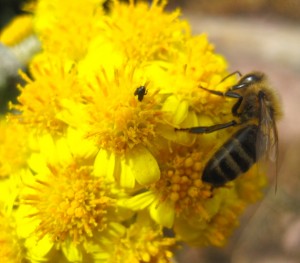
Tags: connections, food, honey bees, science
Posted in Bees, Science | No Comments »
Friday, November 26th, 2021
We are an impossibility in an impossible universe.– Ray Bradbury
The human brain:
- 85 billion neurons (nerve cells)
- Each neuron is unique
- Each neuron connects to 10,000 other neurons
- That’s up to 1,000 trillion connections possible
The universe is not composed of mere matter, but of mind stuff. – Charles Birch
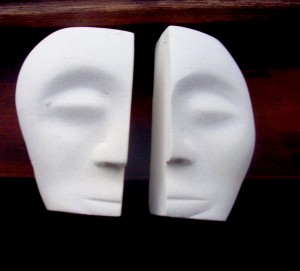
Photo: ‘Facebook’, my limestone bookends inspired by a Polynesian mask.
Tags: brain, connections, consciousness, science
Posted in Science | No Comments »
Friday, November 6th, 2020
Nearly all of the atoms in your body were once cooked in the nuclear furnace of an ancient supernova. – Frances Collins
The story of us began in the stars. The universe expanded after the Big Bang, forming atoms of hydrogen and helium. The atoms gathered in galaxies where they came in handy as fuel for stars. When stars died (supernova) new atoms were released – including carbon and oxygen, happily for us. By and by, over 8 billion years, planets were formed and Earth’s story began.
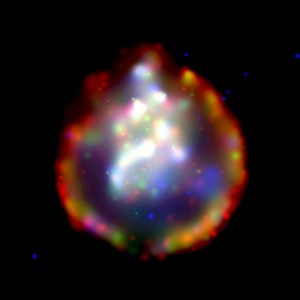
Photo (NASA Images): Star that exploded in a supernova leaving a ring that’s rich in oxygen.
A beautiful star-metaphor appeals to my sense that our cosmic journey has meaning:
The universe is made of stars, not atoms – Muriel Rukeyser
The /Xam San people of Southern Africa knew that humans were related to the stars in a mysterious way. The /Xan suffered a slow genocide in the 1800s but their words remain. Their stories tell us that the stars are closely connected to humans:
“The stars know the time at which we die.” –Díä!kwain, 1876
Tags: connections, science, Universe
Posted in Science, Universe | No Comments »
Wednesday, October 28th, 2020
Writing requires four fundamental steps:
Imagine: ‘Open your mind’ (P.D. James)
Write: ‘Put one word after another’ (Neil Gaiman)
Edit: ‘Omit needless words’ (William Strunk)
Hope: ‘Outrun the self-doubt’ (Stephen King)
The steps of writing harmonise with the four fundamental forces of the physical world:
Electromagnetism: has infinite range, like imagination,
Weak Force: is confined to the atoms, as a writer must be confined to work.
Strong Force: holds nuclei together, as editing strengthens writing.
Gravity: keeps us anchored and has infinite range, like hope.
Read my essay, The Science of Writing.
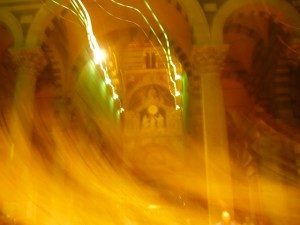
Tags: books, connections, science, writing
Posted in Science, Universe, Writing | No Comments »
Sunday, July 26th, 2020
When truly present in nature, we use all our senses at the same time, which is the optimum state of learning. ― Richard Louv, The Nature Principle
Direct exposure to the natural world is essential for healthy childhood development. Forest schools are springing up all over the world to give children outdoor experiences. I’m a trustee for a new Nature School (in Dunedin, New Zealand) which combines creative play with skill-teaching (bushcraft, beekeeping etc).
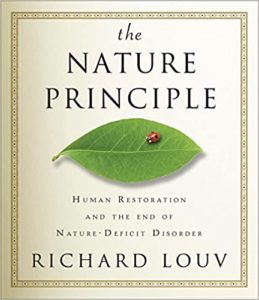
Tags: books, connections, reviews
Posted in Book Reviews | No Comments »
Saturday, May 5th, 2018
Pollination: ‘a love story that feeds the Earth.’ – Louie Schwartzberg
We can’t survive without bees and bees won’t survive unless we love them. It’s a unique partnership between ‘wild’ creatures and humans: honey bees give us fruit, vegetables, and pastures – we must make sure they have a variety of flowering plants and clean habitats (avoid pesticides, especially neonicotinoids).
Human beings have fabricated the illusion that they have the technological prowess to be independent of nature. Bees underline the reality that we are more, not less, dependent on nature’s services. – Achim Steiner
Watch a sweet little film, Dance of the Honey Bee’ (Vimeo).
Everyone loves honey bees…even Daleks:
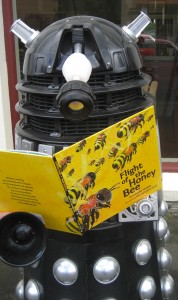
Tags: connections, food, Gardening, honey bees, science
Posted in Bees, Gardening, Science | No Comments »
Saturday, January 7th, 2017
Am I really made of stardust? Yes, many of my (and your) atoms were made in dying stars – when the stars exploded (‘supernova’) the atoms were flung into the universe and eventually became planets and plankton and people. The atoms themselves have not changed but were constantly recycled into different matter – those same atoms of stardust make up 93% of my body mass (some are hydrogen atoms which are actually Big Bang dust). That means I’m billions of years old… which is strange but oddly hopeful.
‘Our presence in the universe is deeply rooted in this cosmic history.’– Marco Bersanelli, physicist.
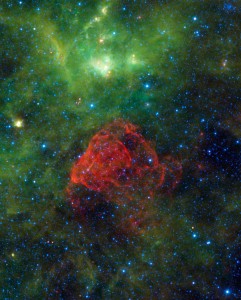 My Mum and Dad? The remnants of two ancient supernova explosions, Puppis and Vela. Image courtesy NASA/JPL-Caltech/UCLA
My Mum and Dad? The remnants of two ancient supernova explosions, Puppis and Vela. Image courtesy NASA/JPL-Caltech/UCLA
Tags: connections, science, Universe
Posted in Science, Universe | No Comments »
Saturday, November 5th, 2016
How doth the little busy bee
Improve each shining hour – Isaac Watts
For a long life, breakfast daily on honey. – Pythagoras
Human beings have fabricated the illusion that they have the technological prowess to be independent of nature. Bees underline the reality that we are more, not less, dependent on nature’s services… – Achim Steiner
Life is all one – as big as the world and as small as a honey bee. – Hattie Ellis
Bees – their feet are dusted with spices from a million flowers. – Ray Bradbury
We have rather chosen to fill our hives with honey and wax; thus furnishing mankind with the two noblest of things, which are sweetness and light. – Jonathan Swift
The comb of the hive bee is absolutely perfect. – Charles Darwin
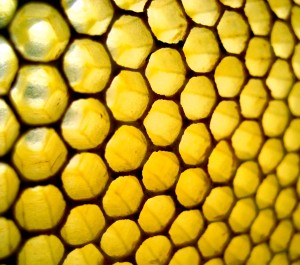
Tags: connections, honey bees
Posted in Bees | No Comments »
Monday, June 15th, 2015
At last, a big picture is emerging in science as links have been found between the small and the large, between quantum physics and biology. The poster child of ‘quantum biology’ is the European robin. The bird uses the Earth’s magnetic field to navigate vast distances – but the field is 100 times weaker than a fridge magnet, so how does the robin detect it? It uses an very finely balanced system that reaches from the sub-atomic level to the biological. Here’s how it seems to work: a photon (‘particle’) of light enters the bird’s eye as it’s flying; the photon is absorbed by a protein molecule in the eye where it causes electrons to become ‘entangled’ (an electron state that’s sensitive to magnetic fields); this creates a chemical change in the protein molecule which sends a signal to the bird’s brain telling it which way to fly. This ‘magneto-reception’ occurs in many bird species (including chickens!), honey bees, dolphins, butterflies, sharks, lobsters and stingrays. This fascinating book tells the full story:
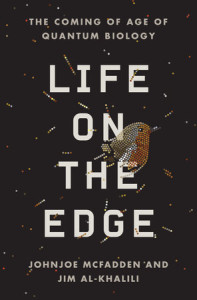
Tags: connections, science
Posted in Science, Universe | No Comments »
Sunday, August 10th, 2014
Does the universe have a purpose or is it an accident? Scientists have divergent views on the significance of the universe. At one end of the spectrum is the iconoclast, Richard Dawkins, who sees an indifferent universe which has “precisely the properties we should expect if there is at bottom no design, no purpose.” At the other end is biologist Jane Goodall who believes the universe is both purposeful and meaningful. In between there are theories ranging from a ‘conscious universe’ to a ‘self-creating universe’. Whatever their beliefs, at least there’s usually a shared sense of wonder among scientists…
…Read the rest of my essay, Science and Soul, here.
 Photo: The remnants of supernova explosions, Puppis and Vela, birthplace of some of our atoms. Image courtesy of NASA/JPL-Caltech/UCLA
Photo: The remnants of supernova explosions, Puppis and Vela, birthplace of some of our atoms. Image courtesy of NASA/JPL-Caltech/UCLA
Tags: connections, consciousness, science, Universe
Posted in Science, Universe | No Comments »
Monday, March 17th, 2014
The classic sci-fi movie, The Incredible Shrinking Man (1958), was about the atomic angst of the 1950s and it’s themes have not dated. The hero is exposed to a radioactive cloud and begins to shrink. Trapped in his home, he battles his cat, a spider, and a leaking tap (always a threat to the male ego). Finally, he’s reduced to his essential self and ponders his place in the universe. This extract is from the closing monologue (script by Richard Matheson):
So close – the infinitesimal and the infinite. But suddenly, I knew they were really the two ends of the same concept. The unbelievably small and the unbelievably vast eventually meet—like the closing of a gigantic circle…
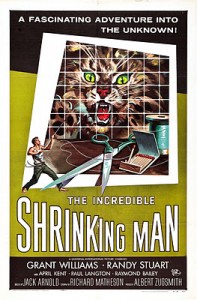
Tags: connections, movies, science fiction, Universe
Posted in Movies, Sci-Fi, Universe | No Comments »
Friday, November 1st, 2013
‘Neonicotinoids’ … a clunky word, but one that everybody should know. They (‘neonics’ for short) are the most widely used insecticides in the world – they’re now found in almost every managed landscape from farms to home gardens (and use is increasing rapidly). Neonics are non-targeted (ie.lazy) pest control: they’re usually coated on seeds and the poison stays in the plant as it grows. And the residue can remain in plant tissue, pollen, soil and water for years – it’s these residues that can kill beneficial wildlife: bees, birds, soil creatures and helper insects. That makes neonics a threat to our food supply because:
- Bees and other pollinators directly provide much of our food
- Soil creatures (worms, microbes) are vital for soil health
- Helper insects (predatory and parasitic species) provide natural pest control
Why would we want to harm any of these? The EU has put a two year ban on neonics (because of damage to bees)but they are still used in NZ and are available to the public. Let’s ask garden and hardware shops to stop selling them (Placemakers and The Warehouse have recently withdrawn them) and the EPA to ban them.
Research: neonicotinoids harming honey bees
Report: effect of neonicotinoids on beneficial insects.
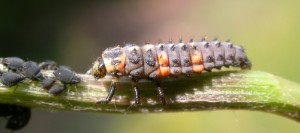 The larval stage of a ladybird (right) loves to eat aphids (left) – great natural pest control.
The larval stage of a ladybird (right) loves to eat aphids (left) – great natural pest control.
Tags: connections, food, Gardening, honey bees, science
Posted in Bees, Science | No Comments »
Thursday, September 19th, 2013
In the 1960s, Jane Goodall was criticised for saying chimpanzees have emotions. Today the evidence suggests she’s right although scientists remain wary of anthropomorphism – associating human traits with animals – often with good reason (eg. the gross inaccuracy of The Bee Movie in which boy bees did the work). Of course animals don’t see the world exactly we do, but we shouldn’t ignore what we have in common with them:
Anthropo-denial: A blindness to the humanlike characteristics of other animals, or the animal-like characteristics of ourselves. – F. de Waal
The weight of scientific evidence is that animal have thoughts, feelings and intelligence – animals are not mere ‘survival machines’. It’s now accepted that humans and animals share many traits (Marc Bekoff (The Emotional Lives of Animals); this fits nicely with evolution which teaches us animals are our relatives and all life is connected. Forgetting this relationship has led to the honey bee crisis, for example, as people have treated bees as tools rather than partners in pollination.
Acknowledged as individuals, those sparrows, salamanders and squirrels are not interchangeable parts of a species machine. They are beings with their own inner lives and experiences. – Brandon Keim (Animal Consciousness)
Using language that reflects our ‘common ground’ can help give children empathy with the natural world. When writing Flight of the Honey Bee I wanted accurate science yet also a sense of a bee’s experience. Should I use human concepts such as ‘know’, ‘remember’, captivate’, and ‘story’? Should I even call the bees ‘sisters’? The answer was yes. Honey bees have language, intelligence, and memory (and maybe something like emotions); and they’re more genetically sisters than humans.
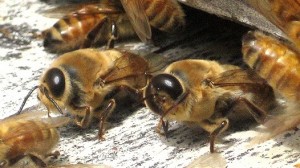
They are not us, but to look into their eyes is to know that someone is in there. Imposing our own specific thoughts and feelings on that someone is in one sense too imaginative, in presuming he could receive the world in the way we do, and in another not imaginative enough, in not opening our minds to the full possibilities of his difference.- Caitrin Nicol (Do Elephants Have Souls?)
Tags: connections, honey bees, science, writing
Posted in Bees, Science, Writing | 2 Comments »
Sunday, January 6th, 2013
Why Does The World Exist? by Jim Holt is a fascinating book that asks the question, ‘Why is there something rather than nothing?’ Holt looks at all sides of the question, interviewing scientists, philosophers, atheists and believers (Richard Swinburne, John Irving, Roger Penrose, Adolf Grunbaum…). There are three types of theorist:
The “optimists” hold that there has to be a reason for the world’s existence and that we may well discover it. The “pessimists” believe that there might be a reason for the world’s existence but that we’ll never know for sure… Finally, the “rejectionists” persist in believing that there can’t be a reason for the world’s existence, and hence that the very question is meaningless.
Leibniz’s Principle of Sufficient Reason says that ‘For every thing there must be a reason for that thing’s existence‘, which is the basis of our scientific worldview. Holt does a good job of summarizing some knotty philosophy, physics and maths (understanding it is another matter!). Although he offers no firm answers, the book left me feeling “optimistic”; and it’s oddly comforting that after picking the brains of the world’s greatest thinkers, Holt concludes,
No one can confidently claim intellectual superiority in the face of the mystery of existence.
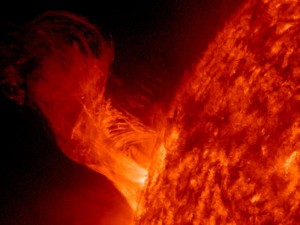
Photo: Solar eruption, Dec 31, 2012 – courtesy of NASA Images
Tags: books, connections, reviews, science, Universe
Posted in Book Reviews, Science, Universe | No Comments »
Tuesday, March 20th, 2012
Dark matter is the missing link.Stuart Clark
Our universe exploded into being about 14 billion years ago, for motives which are unclear. Equal amounts of matter and anti-matter were made but most of the anti-matter mysteriously disappeared. And so the universe became biased towards life (matter). But only a ‘mere- smear’ of the universe is Normal Matter – that’s the atoms in stars, planets, you and me – the bulk is dark stuff.
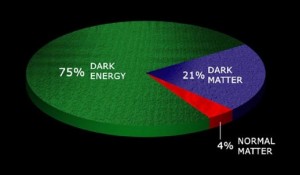
This pie (Image: NASA/CXC/M.Weiss) shows the ingredients of the universe. Most of it is Dark Energy that hides in the vacuum of space. We don’t yet know what it is, but it’s made the universe expand. Dark Matter is made of particles that are also invisible to us but we can see galaxies being affected by its force. The smallest slice of the universe is Normal Matter. Matter is built up from extremely small bits to extremely big bits: from inner space to outer space. Sub-atomic particles are arranged into atoms, atoms into molecules; molecules into cells and organisms; and so on up to galaxies and dark stuff. Everything belongs.
We exist only because of subtle connections between the very small and the very large. Charles Birch
Tags: connections, science
Posted in Science, Universe | No Comments »
Wednesday, April 13th, 2011
Writer Dorothy Sayers (in The Mind of the Maker, 1941) suggested every creative act has three elements: Idea, Energy and Power. The Idea remains intangible until the story writing begins. The Energy is the activity of writing the book. The Power is the response the book produces in the reader – ‘The thing that flows back to the writer’.
I’m amazed when starting a new story how a shapeless idea in my head generates a story. As the characters are given energy they help me create the story; and by the end it’s as if they always existed. Then each reader has a unique response to the book.
Tags: connections, writing
Posted in Writing | No Comments »
Wednesday, March 2nd, 2011
I was writing a story on an iPad near Christchurch last week. Writing tools such as computers have become flexible, but perhaps less intimate, and I wonder if it affects my writing. When Ted Hughes began writing on a typewriter he noticed he became less concise. Writing by hand had made him invest more in each word:
every year of your life is right there, wired into the communication between your brain and your writing hand… things become automatically more compressed, and, perhaps, psychologically denser.
The Shallows, by Nicholas Carr, brilliantly examines how our brains react to computer use ( read a great essay about the book here). He says that working on computers can be distracting (rather than 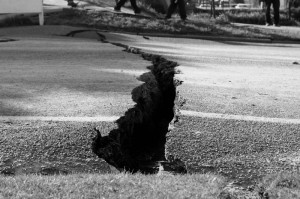 reflective) for the brain — so it stays in the shallows, barely engaging with the myriad connections at deeper levels. In that case the iPad might be okay for writing because you can fade out all but the sentence you’re on. But my iPad trial was interrupted by the earthquake — which came from the shallows with terrifying force.
reflective) for the brain — so it stays in the shallows, barely engaging with the myriad connections at deeper levels. In that case the iPad might be okay for writing because you can fade out all but the sentence you’re on. But my iPad trial was interrupted by the earthquake — which came from the shallows with terrifying force.
Photo: Allen Carbon
Tags: brain, computers, connections, ipad, quake, writing
Posted in Writing | 2 Comments »















